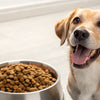How Much Does a Cup of Dog Kibble Weigh? Understanding Pet Nutrition for Optimal Health
- Houndsy
Table of Contents
- Introduction
- What is “a Cup” of Dog Food, Exactly?
- The Importance of Accurate Measurements
- How to Measure Dog Food: Best Practices
- Conclusion
Introduction
As devoted pet parents, we all want the best for our furry friends. A significant aspect of their health and well-being hinges on proper nutrition, which includes knowing exactly how much to feed them. Did you know that a recent study revealed that nearly 60% of dog owners do not measure their pets' food accurately? This can lead to serious health consequences, including obesity and malnutrition. With so many types of dog kibble available, understanding how much a cup of dog kibble weighs is essential.
In this blog post, we will explore the intricacies of dog food measurements, the factors that impact how much a cup of kibble weighs, and the best practices for feeding our dogs. By the end of this article, you will have a comprehensive understanding of how to measure dog food accurately, ensuring your pet receives the right amount of nutrition tailored to their individual needs. Let's dive into the world of dog feeding and discover how we can elevate this essential routine.
What is “a Cup” of Dog Food, Exactly?
When it comes to measuring dog food, the term "cup" can be misleading. In the context of dog kibble, a cup typically refers to a standard 8-ounce measuring cup. However, not all measuring cups are created equal, and the weight of a cup of kibble can vary significantly depending on various factors.
The Variability of Kibble Weight
The weight of one cup of dog kibble is not a fixed value. It can range from 3 to 5 ounces, depending on the brand and formulation of the kibble. Factors that influence this variability include:
- Kibble Size and Shape: Different brands and types of kibble have varying sizes and shapes. Smaller, denser kibble may weigh more per cup compared to larger, airier kibble.
- Moisture Content: Kibble with higher moisture content may weigh less than dry kibble. If you're using semi-moist or fresh food, the weight can fluctuate even more.
- Ingredient Density: Ingredients used in the kibble formulation can also affect its weight. For example, kibble made with high-protein meats may weigh differently than grain-based kibble.
Measuring Cups vs. Digital Scales
To accurately determine how much a cup of dog kibble weighs, we recommend using a digital kitchen scale. While traditional measuring cups can provide a rough estimate, they are often imprecise. For instance, if you pour kibble into a cup, you might not have an accurate measurement due to the kibble's shape.
To measure accurately, follow these steps:
- Weigh the Empty Cup: Place the empty measuring cup on the digital scale and note its weight.
- Tare the Scale: Reset the scale to zero.
- Add Kibble: Fill the cup with kibble until you reach the desired amount (e.g., one cup).
- Record the Weight: Note the weight of the kibble alone.
Example of Kibble Measurement
Let's say you weigh your measuring cup and find it weighs 2 ounces. After filling it with kibble, the scale reads 6 ounces. Therefore, one cup of that particular kibble weighs 4 ounces (6 ounces - 2 ounces = 4 ounces).
By using a scale, you can ensure that you are feeding your dog precisely the right amount of food, which is crucial for maintaining their health.
The Importance of Accurate Measurements
Feeding our dogs the correct amount of food is vital for their overall health and well-being. Improper measurements can lead to several issues, including:
- Obesity: Exceeding the recommended caloric intake can lead to weight gain and obesity, which is a growing concern in the pet population. According to the Association for Pet Obesity Prevention, approximately 60% of dogs in the United States are classified as overweight or obese.
- Malnutrition: Conversely, underfeeding can lead to malnutrition, depriving dogs of the essential nutrients they require for optimal health.
Calculating Daily Caloric Needs
Determining how much to feed your dog requires understanding their daily caloric needs. Factors that affect this include:
- Age: Puppies require more calories for growth, while senior dogs may need fewer calories to maintain their weight.
- Size and Breed: Larger breeds often require more food than smaller breeds.
- Activity Level: Active dogs will need more calories compared to those that are sedentary.
To calculate your dog’s daily caloric needs, consider using a pet calorie calculator or consult with your veterinarian. Once you know the total caloric requirement, you can convert this into cups of kibble based on the weight of the kibble you have measured.
How to Measure Dog Food: Best Practices
To ensure your dog receives the right amount of food every time, consider these best practices:
1. Use a Digital Scale
As mentioned earlier, using a digital scale is the best way to measure dog food accurately. This eliminates guesswork and ensures consistency in portion sizes.
2. Read the Labels
Many dog food brands provide information on the weight of one cup of their kibble on the packaging. If unavailable, you can contact the manufacturer for precise information.
3. Adjust Portions Based on Your Dog’s Needs
Regularly assess your dog’s weight and adjust their food portions accordingly. Weight management is crucial for overall health; consider consulting with your veterinarian for tailored feeding recommendations.
4. Invest in a Quality Kibble Dispenser
Our flagship product, the Houndsy Kibble Dispenser, is designed to simplify the dog-feeding experience. It features an ergonomic crank for easy dispensing at standing height, perfect portion control, and a stylish mid-century modern design that complements any home décor. With a storage capacity for 25 to 30 lbs of kibble, it helps keep your dog’s food fresh and accessible while reducing mess.
Conclusion
Understanding how much a cup of dog kibble weighs is essential for maintaining our pets' health. Accurate measurement prevents both obesity and malnutrition, ensuring that our furry friends receive the right amount of nutrition tailored to their needs. By using a digital scale, reading labels, and investing in tools like the Houndsy Kibble Dispenser, we can elevate the daily feeding ritual for our dogs.
As you reflect on your pet feeding routine, consider incorporating these best practices for a healthier, happier dog. Are you ready to take the next step in enhancing your dog’s feeding experience? Explore our Houndsy Kibble Dispenser today!
FAQ
1. How much does a cup of dog kibble typically weigh? The weight can vary significantly based on the brand and formulation, typically ranging from 3 to 5 ounces per cup.
2. Why is it important to measure dog food accurately? Accurate measurements help prevent obesity and malnutrition, ensuring your dog receives the right amount of calories for their health.
3. How can I determine my dog’s daily caloric needs? Factors such as age, size, breed, and activity level influence caloric needs. You can use a pet calorie calculator or consult your veterinarian for specific recommendations.
4. What’s the best way to measure dog food? Using a digital scale is the most accurate method. Measure the weight of the food without including the weight of the measuring cup.
5. How can the Houndsy Kibble Dispenser help with feeding? The Houndsy Kibble Dispenser offers ergonomic convenience, perfect portion control, and a stylish design, making it easier to feed your dog accurately and beautifully.












